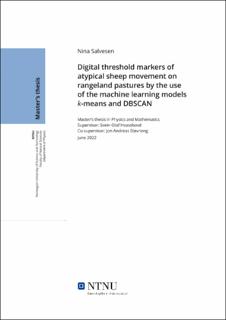| dc.description.abstract | Determining the data driven description of the behaviour in sheep on rangeland grazing pastures is in demand to ensure welfare and sustainability in both Norwegian and worldwide modern pastoral systems. This study investigated the movement pattern of sheep on rangeland pastures in Norway in terms of different types of breed and diurnal and seasonal behavior traits. High resolution digital GPS collar data on free range sheep enables a deeper dimension of research on typical sheep behavior. The research in this thesis was done with the unsupervised machine learning models \textit{k}-means and DBSCAN and statistical analysis. Data from 391 sheep of six breeds in five different grazing areas from 2012-2016 and 2018-2020 was studied. Variables included in the analysis were time of day, activity levels, altitude, trajectory angle, season, breed, number of lambs, temperature, and age of sheep. Diurnal behavioural traits could be identified, and the \textit{k}-means model categorized their day into four characteristic activity periods. Digital threshold marker values were calculated from the mean of the behavioural outliers detected by the DBSCAN model, which when triggered indicate possible atypical movement patterns. The analysis found that the sheep velocity threshold marker should be considered split into four different values based on the circumstances surrounding the herd. The threshold marker values may be used as trigger conditions in future collar alerting technology, and thus give more specialized herd welfare warnings to the farmer. | |
